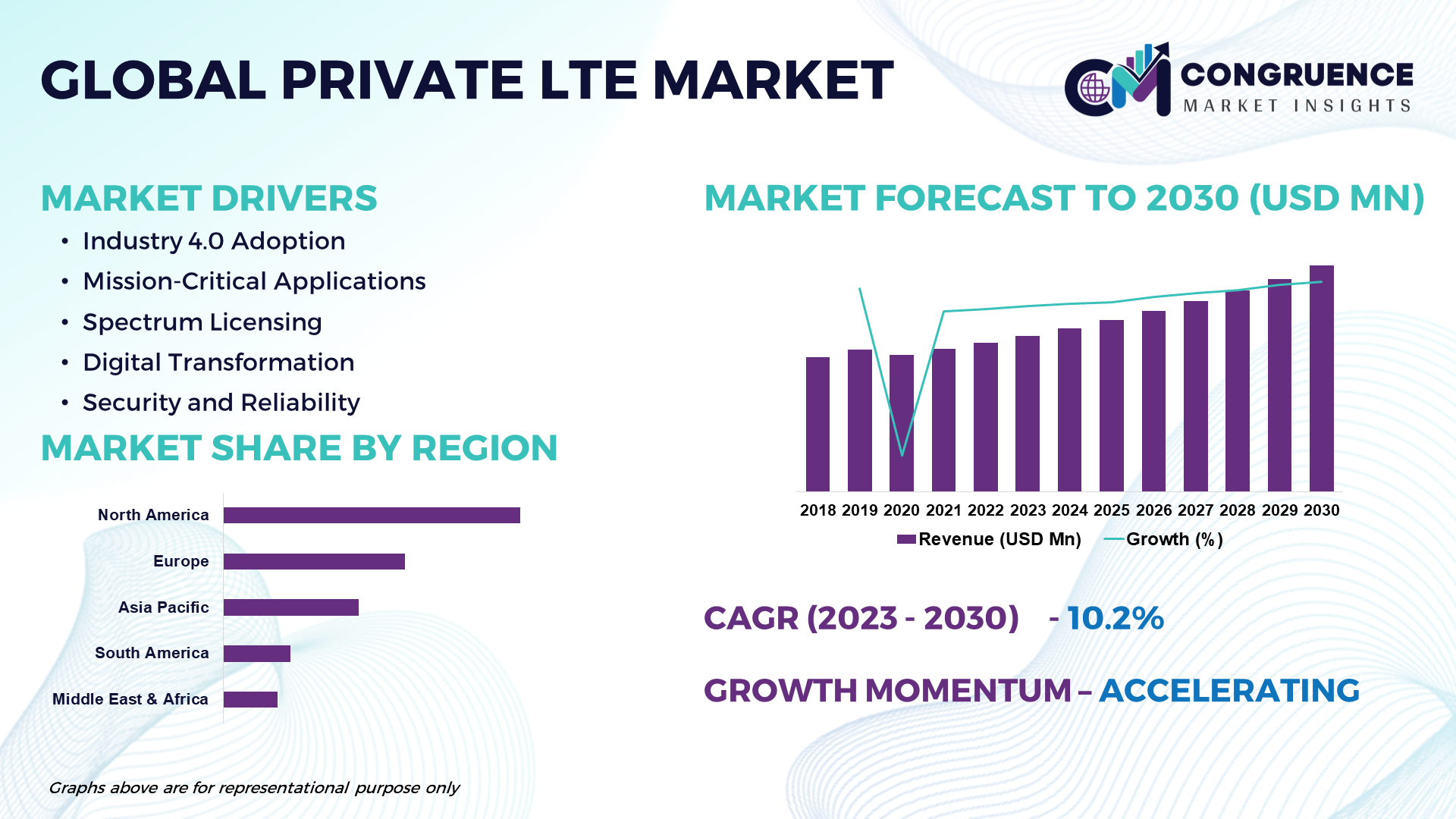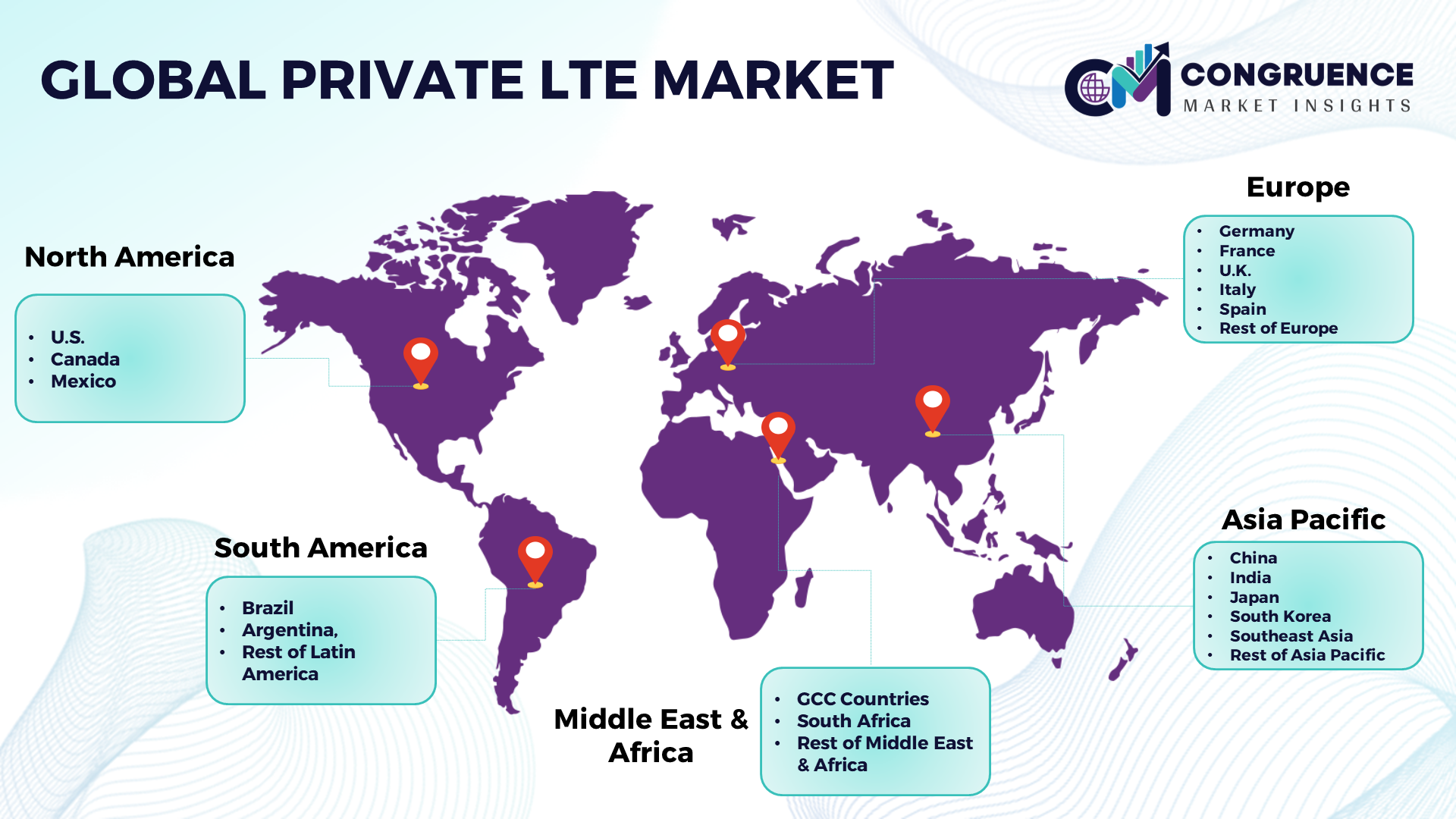Reports
The Global Private LTE Market is projected to expand at a substantial CAGR of 10.2% from 2023 to 2030, fueled by factors such as the proliferation of Internet of Things (IoT) devices, digital transformation initiatives, and the adoption of Industry 4.0 technologies. Private LTE (Long-Term Evolution) networks are cellular networks that operate on dedicated or licensed spectrum bands, providing high-speed wireless connectivity for specific enterprise, government, industrial, and critical infrastructure applications. These networks offer robust, secure, and reliable wireless communication solutions, enabling organizations to meet their unique connectivity requirements and support mission-critical applications. The Private LTE Market is witnessing significant growth driven by the increasing demand for reliable and high-performance wireless communication networks in various industries such as manufacturing, transportation, energy, and public safety. Private LTE networks offer advantages such as low latency, high bandwidth, improved security, and seamless connectivity, making them suitable for applications such as industrial automation, asset tracking, remote monitoring, and video surveillance.

Private LTE Market Major Driving Forces
Industry 4.0 Adoption: The adoption of Industry 4.0 technologies such as automation, robotics, and IoT devices in manufacturing, logistics, and supply chain management is driving the demand for Private LTE networks to enable real-time data transmission, process optimization, and operational efficiency.
Mission-Critical Applications: The need for reliable, low-latency wireless connectivity for mission-critical applications in industries such as public safety, defense, utilities, and transportation is driving the adoption of Private LTE networks to ensure seamless communication and operational continuity.
Spectrum Licensing: The availability of licensed spectrum bands for private network deployments, along with regulatory initiatives to allocate dedicated spectrum for industrial and enterprise use, is driving the adoption of Private LTE networks for organizations seeking exclusive and interference-free wireless connectivity.
Digital Transformation: The ongoing digital transformation across industries, fueled by trends such as cloud computing, edge computing, and data analytics, is driving the demand for Private LTE networks to support emerging use cases such as smart factories, smart cities, and connected vehicles.
Security and Reliability: The need for secure and reliable wireless communication solutions to protect sensitive data, ensure privacy, and mitigate cyber threats is driving the adoption of Private LTE networks, which offer enhanced security features such as encryption, authentication, and network segmentation.
Private LTE Market Key Opportunities
Vertical-Specific Solutions: The development of vertical-specific Private LTE solutions tailored to the unique connectivity requirements of industries such as manufacturing, healthcare, mining, and agriculture presents lucrative opportunities for network equipment vendors, system integrators, and service providers.
Hybrid Network Deployments: The adoption of hybrid network deployments combining Private LTE networks with public cellular networks or other wireless technologies such as Wi-Fi and LPWAN (Low-Power Wide-Area Network) presents opportunities for organizations to leverage the benefits of both private and public connectivity options.
Edge Computing Integration: The integration of edge computing capabilities into Private LTE networks to enable real-time data processing, low-latency analytics, and distributed intelligence presents opportunities for organizations to deploy advanced applications and services at the network edge for improved operational efficiency and decision-making.
Managed Services: The growing demand for managed Private LTE services, including network design, deployment, monitoring, maintenance, and support, presents opportunities for managed service providers to offer comprehensive solutions to enterprises and industries seeking turnkey connectivity solutions.
Smart Infrastructure Projects: The increasing investments in smart infrastructure projects such as smart cities, smart grids, and smart transportation systems present opportunities for Private LTE deployments to support advanced applications such as intelligent traffic management, energy distribution automation, and public safety services.
Private LTE Market Key Trends
· Network Slicing: The adoption of network slicing technologies in Private LTE networks to create virtualized network slices tailored to specific use cases, applications, or user groups, enabling efficient resource allocation, QoS (Quality of Service) management, and network optimization.
· Integration with 5G: The integration of Private LTE networks with emerging 5G technologies such as standalone (SA) architecture, network slicing, and ultra-reliable low-latency communication (URLLC) to deliver enhanced connectivity, performance, and scalability for mission-critical applications and industrial IoT deployments.
· Cloud-Native Deployments: The adoption of cloud-native architectures and cloud-based deployment models for Private LTE networks to improve agility, scalability, and cost-effectiveness, enabling organizations to deploy and manage network resources dynamically based on demand and usage patterns.
· Open RAN (Radio Access Network): The adoption of open RAN architectures and standards in Private LTE networks to promote interoperability, vendor neutrality, and flexibility in network deployments, enabling organizations to leverage multi-vendor solutions and optimize network infrastructure investments.
· Private Network-as-a-Service (NaaS): The emergence of Private Network-as-a-Service (NaaS) offerings from telecom operators and managed service providers, enabling organizations to deploy and manage Private LTE networks as a subscription-based service, reducing upfront capital investments and simplifying network operations.

Market Competition Landscape
The Global Private LTE Market is characterized by intense competition among key players and network equipment vendors offering a wide range of hardware, software, and services for Private LTE deployments. Market players are focusing on strategic initiatives such as product differentiation, partnerships, mergers and acquisitions, and geographic expansion to strengthen their market position and gain a competitive edge. Prominent players in the Private LTE Market include:
· Nokia Corporation
· Ericsson AB
· Huawei Technologies Co., Ltd.
· ZTE Corporation
· Samsung Electronics Co., Ltd.
· Cisco Systems, Inc.
· NEC Corporation
· Motorola Solutions, Inc.
· Sierra Wireless, Inc.
· Qualcomm Incorporated
These companies are actively involved in product innovation, research and development, and market expansion initiatives to address evolving customer needs and market demands.
|
Report Attribute/Metric |
Details |
|
Base Year |
2022 |
|
Forecast Period |
2023 – 2030 |
|
Historical Data |
2018 to 2022 |
|
Forecast Unit |
Value (US$ Mn) |
|
Key Report Deliverable |
Revenue Forecast, Growth Trends, Market Dynamics, Segmental Overview, Regional and Country-wise Analysis, Competition Landscape |
|
Segments Covered |
· By Component (Hardware, Software, Services) · By Technology (FDD, TDD) · By Deployment Model (On-Premises, Cloud) · By End-user (Enterprises, Government & Defense, Industrial, Energy & Utilities, Transportation, Others) |
|
Geographies Covered |
North America: U.S., Canada and Mexico Europe: Germany, France, U.K., Italy, Spain, and Rest of Europe Asia Pacific: China, India, Japan, South Korea, Southeast Asia, and Rest of Asia Pacific South America: Brazil, Argentina, and Rest of Latin America Middle East & Africa: GCC Countries, South Africa, and Rest of Middle East & Africa |
|
Key Players Analyzed |
Nokia Corporation, Ericsson AB, Huawei Technologies Co., Ltd., ZTE Corporation, Samsung Electronics Co., Ltd., Cisco Systems, Inc., NEC Corporation, Motorola Solutions, Inc., Sierra Wireless, Inc., and Qualcomm Incorporated |
|
Customization & Pricing |
Available on Request (10% Customization is Free) |
